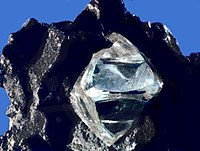
Photo from wikipedia
The purpose of this in vitro study was to investigate the effects of different air-abrasion pressures on flexural strength and shear bond strength of a translucent zirconia. The translucent zirconia… Click to show full abstract
The purpose of this in vitro study was to investigate the effects of different air-abrasion pressures on flexural strength and shear bond strength of a translucent zirconia. The translucent zirconia surface was treated with 50 μm abrasive alumina particles at different pressure: 0.1 MPa; 0.2 MPa; 0.3 MPa; 0.4 MPa; 0.5 MPa; untreated specimens were used as control group (n = 33). For each group, three-point bending test was used to evaluate the flexural strength, and surface characterizations were analyzed. Following adhesive bonding and water storage for 24 h, specimens were subdivided into groups baseline and aged (5000 thermocycles). Then, shear bond strength was measured and failure mode was recorded. Statistical analysis was performed with one-way ANOVA and Tukey test (α = 0.05). Increasing air-abrasion pressure (0.3 MPa, 0.4 MPa, and 0.5 MPa) decreased the flexural strength. Higher air-abrasion pressure resulted in rougher zirconia surfaces and caused more microcracks. The highest shear bond strength was obtained for zirconia surfaces abraded at 0.2 MPa (15.88 ± 2.70 MPa) and 0.3 MPa (14.32 ± 1.12 MPa). Aging did not decrease the strength for all groups except control group (p < 0.001). Air-abrasion with 50 μm abrasive alumina particles at 0.2 MPa could achieve good strength for translucent zirconia ceramics while maintaining adequate and durable bonding with resin cement. A total of 0.2 MPa is recommended for air-abrasion procedure applied before a dental restoration fabricated with translucent zirconia is bonded to resin cement.
Journal Title: Clinical Oral Investigations
Year Published: 2020
Link to full text (if available)
Share on Social Media: Sign Up to like & get
recommendations!